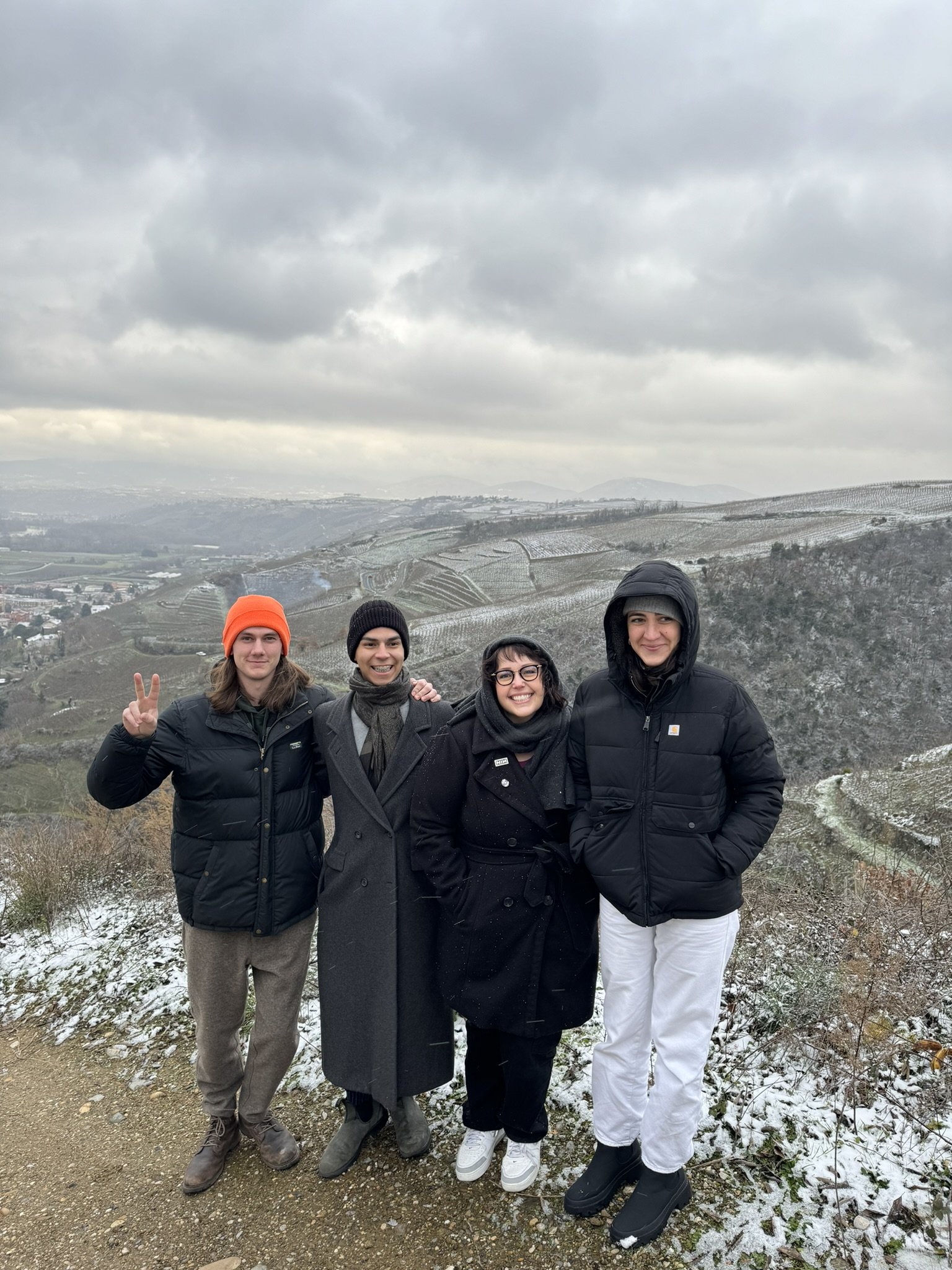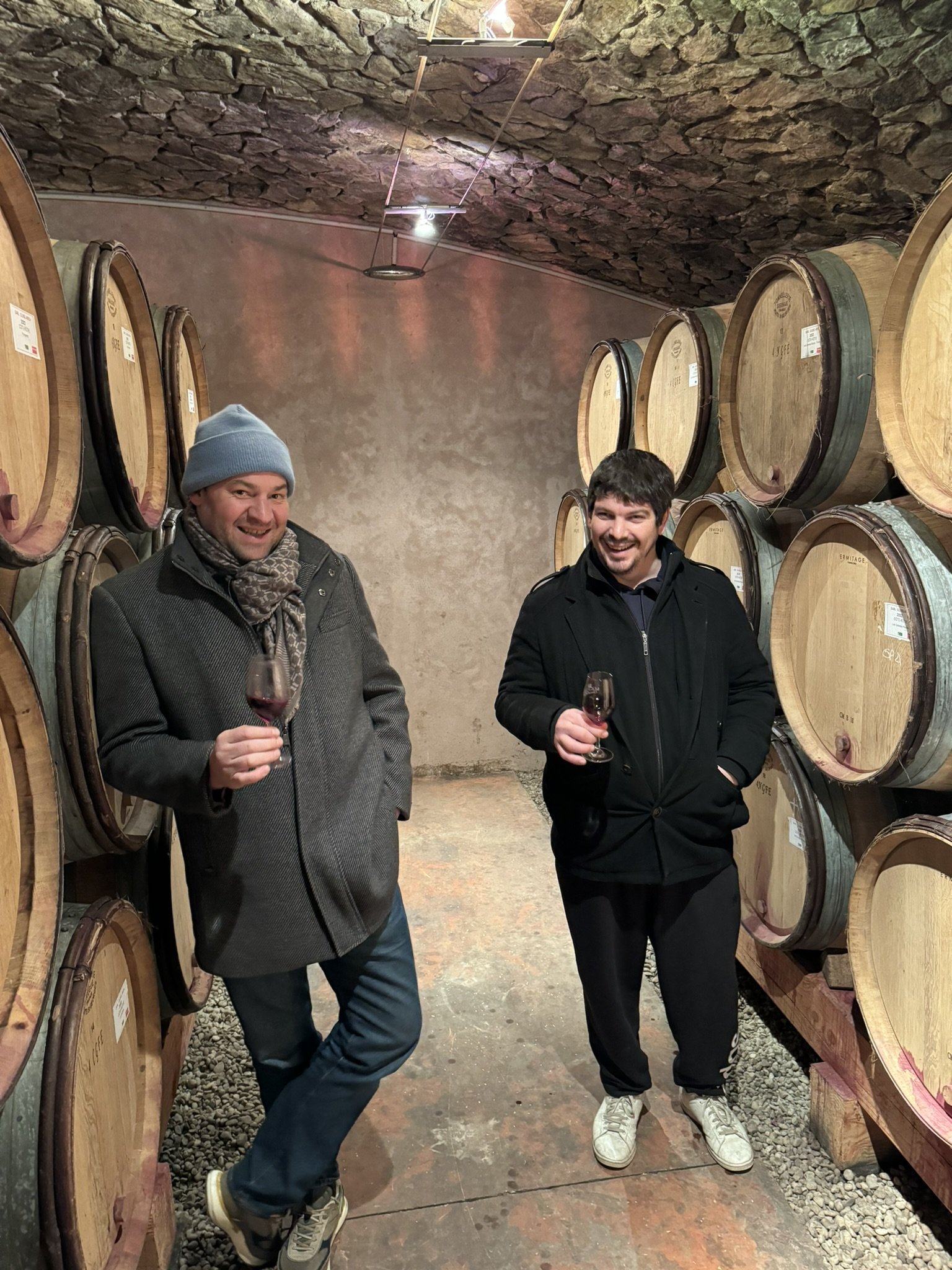Sommelier Scholarship trip to the Northern Rhône - Part 1 - Clusel-Roch
by Max Goldberg Liu
Friday, January 19, 2024
It was a great pleasure to co-lead another trip to the Northern Rhône on behalf of Sommelier Scholarship Fund - the previous trip was in the midst of last July’s heat wave, and this time we got to experience the opposite weather extreme. The vineyard tours were quite chilly, but the cold made for perfect Syrah-drinking.
Our great group of passionate sommelier-scholars included Danny Agusto of Aska (Brooklyn), Laura Madera-Nadal of Pio Pio (San Juan, PR), Cara Patricia of DecantSF (San Francisco), and Matt Turner of Roscioli (NYC).
We began up north in Côte-Rôtie, spending a whole afternoon and evening with the ambitious and tireless Guillaume Clusel at his family estate Maison Clusel-Roch in Verenay. Clusel-Roch is well known for being one of the first three producers in Côte-Rôtie to begin farming organically as early as the 1980’s, no small feat in the ridiculously difficult terrain of the appellation, where much of the plowing has to be done row by row via gas-powered winch. Clusel is also a leading force in the preservation of Côte-Rôtie’s signature low-yielding selection of Syrah called “Serine,” even going so far as to managing their own nursery with cuttings from their 90 year old vines in Les Grandes Places.
Guillaume first had us pile into his van for an extended tour of the Côte Brune, visiting his vines in Champon, Le Plomb, Viallière, and Grandes Places, as well as having a peek at La Landonne. Despite the 20ºF chill and blistering winds, we still saw a few hardy vineyard workers pruning the steep slopes, a testament to the regional vignerons’ intense dedication to the terroir.
Escaping the cold, we then tasted at the domaine. Alongside the estate’s classic Côte-Rôties and Condrieu, Guillaume also enthusiastically works with other grapes and appellations - fun and fruity Gamay from the Coteaux du Lyonnais (“Traboules” and the soon to be retired “Galet”), zippy and mineral Aligoté from Mâcon (La Bergerie), and the slightly exotic yet fresh “Sur Le Mont”, a field blend of Viognier, Roussanne, Altesse, and Clairette planted on the top of Côte-Rôtie (outside of the appellation).
Also not to be missed is Clusel’s Côtes-du-Rhône “Vergers” - which will probably be the best $60 bottle of CDR that you’ll ever find, as it’s from a vineyard that is completely surrounded by Côte-Rôtie and is essentially the same terroir. It was not part of the Côte-Rôtie classification because the original owner was growing fruit trees on the land at the time, and didn’t want to pay the extra tax applied to vineyard land! So today, we are the beneficiaries of that economic decision.
Of course, we mustn’t forget about the reason we were there: the Côte-Rôties. Historically the appellation has focused much more on blending parcels than bottling individual lieux-dits, with the noted exception of Guigal’s “La-Las.” Clusel-Roch has mostly followed suit, with the bulk of the their Côte-Rôtie production in the form of the “Classique” cuvée (now called “Les Schistes”) but since 1990 has bottled their entire parcel of “Les Grandes Places" separately, and since 2009, a portion of “Viallière.” While the two parcels are next to each other on a map, they couldn’t be more different - Grandes Places being relatively flat with deeper soils, and Viallière on an extreme slope with very little topsoil above the iron-rich mica schist. I usually find the Viallière to be more delicate (for Côte-Rôtie), floral, and fine-grained, compared to the Grandes Places which can be dense, chewy, and monolithic in its youth before softening with age. These profiles were readily apparent in the 2022’s and 2023’s that we tasted from barrel with Guillaume and his business partner Gaëlle.
We also tasted each other lieu-dit that is vinified separately - Bonnivières, Champon, Leyat, Côte-Rôzier. Moving forward, Guillaume has made the commitment to bottle a portion of these lieux-dits separately in vintages that produce notable variations between them. Tasting them, I do still think that the Grandes Places and Viallière are a class above, but it will be interesting to follow the new project as it moves along.
With regards to the vintages, the 22’s will be bottled in April, and showed the density and structure of a modern warm vintage. The 23’s are of course very young still but showed a nice core of fruit and freshness on the palate, showing promise in a very difficult vintage marked by major mildew pressure in July.
Tasting all those wines certainly whet our appetites, and we then sat down to a fabulous dinner prepared by Guillaume (who was well-trained by his mother Brigitte, a famously incredible cook) - homemade foie gras terrine paired with Condrieu 2017, 2007, and 1991 (a great pairing for Condrieu), followed by pot au feu paired with a succession of Côte-Rôties - including the superb 2009 Viallière, its first vintage bottled separately - back to 1989 Classique (my and Guillaume’s birth year!), which showed a wonderful mix of black fruit, spice, and a hint of truffle.
A great first day in the Rhône!


